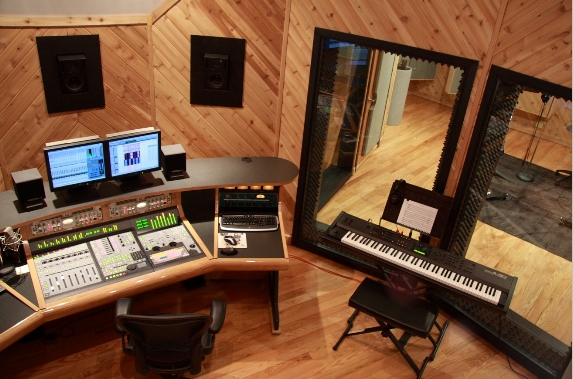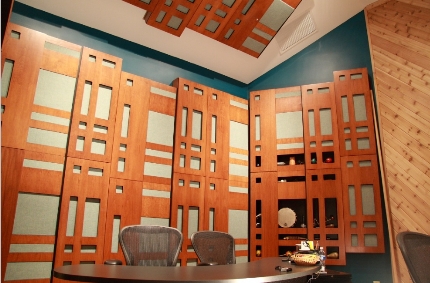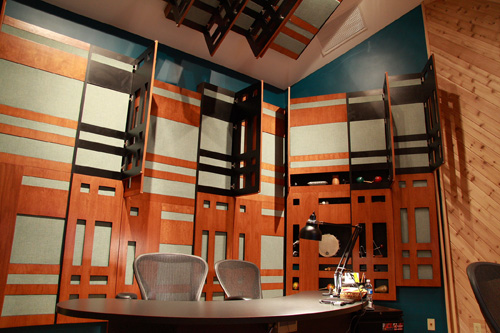Variable Reflection Free Zone Control Room Gives Sound Designers More Options
Jon Mooney - mooneyjw@kjww.com
Seth Harrison, Jon Brennan
KJWW Eng. Consultants
623 26th Ave., Rock Island, IL 61201
Popular version of paper 5aAA6
Presented Friday morning, May 22, 2009
157th ASA Meeting, Portland, OR
The new production studio and control room at Curtis, Inc. in Cincinnati, Ohio includes a “Reflection-Free Zone” and adjustable acoustics in its design, giving sound designers more flexibility. Fewer than 75 control rooms in the United States are set up this way, rather than the conventional “live end/dead end” (LEDE) design.

WATCH: Video of control room acoustics
“This design does away with that presupposition that the room has to be dead,” said Jon Mooney, senior engineer with KJWW Engineering Consultants. Instead, the RFZ allows the sound designer to adjust the liveliness of the room for their use.
A LEDE control room is designed to absorb all reflections from the speakers in the front of the room. One problem with that design is that it makes the whole room relatively dead -- the sound is heard once from the speakers, and then all reflections are quickly absorbed by the room.
A Reflection Free Zone allows the room to still have reflections, but they are not heard immediately by the sound engineer. The design directs speaker reflections from the front of the room away from the recording engineer and extends the initial time delay without requiring a “dead” front end.
“This creates a much livelier sound because you didn’t absorb all of that energy to begin with,” Mooney said.
The initial time delay, which is the amount of time between when the sound designer hears the sound from the speakers and when he hears it coming from reflections in the room, can be adjusted for different effects. This also has the benefit of making the room sound larger than it actually is, if necessary.
The control room features beautiful, cherry wall storage cabinets that serve triple duty as acoustic treatments whose doors can be opened in varying degrees to adjust the absorption and diffusion within the space. The sound designer can adjust the reverberation of the room to create the best sound. The cabinet doors can be opened to create a fairly dead room as well, giving the sound designer the option of a traditional-sounding control room.

Doors closed for maximum diffusion.

Doors open revealing absorbent fiberglass material
The studio also features variable acoustics in its design: large hinged boxes attached to the walls (affectionately known as “wall coffins”) that allow the reverberation and diffusion of the studio to be easily adjusted over a wide range.

“Acoustically the control room feels very open, acoustically diffusive,” said Jon Brennan, Sound Designer and Music Composer at Curtis, Inc. “ The room is a bit more lively then other control rooms; however opening the diffuser doors has a large effect on lowering the reverberation time and focusing the sound, direct from the speakers.”
KJWW also put together a manual for Curtis, Inc. with instructions on how to operate the variable acoustic components of both the studio and control room to achieve desired acoustic effects.
“Recording engineers have their own favorite sounds,” Mooney said. “It’s our job as acoustic consultants not to dictate what that environment should be, but allow the recording engineer to be the test pilot and judge for themselves what that should be.”
Recording with adjustable acoustics changes the way recording is done, Brennan said. In other studios it is common to place a performer in a desired area of the room with certain acoustics, like a live area vs. a dead area. With adjustable acoustics; the entire room can be tuned or tailored to a specific performance. This adds a greater flexibility not otherwise possible. One song may have many different acoustic settings. In a multi-track recording each instrument or part may have a different room tuning. This makes for a very dynamic and creative recording.
“I had a solo classical player in (the studio recently),” Brennan said. “After closing about half of the doors, her instrument came to life and really utilized the natural reverb in the room.”
In addition to monitoring and mixing, Brennan has found the acoustics and low noise floor of the control room to be ideal for the recording of sound effects. When recording foley it is important to be able to record and manipulate sound in the control room. There often isn’t time to setup mics in the studio and call a 2nd engineer to run the session. We keep a mic ‘live’ on the mixing desk to capture that moment’s creative inspiration.
“Both rooms have proven to be very versatile and great sounding,” he said.
“Recordings and mixes from the control room have translated very well on other audio systems. This shows that the room is not coloring the sound. The very low noise floor in the control room and studio has added a greater amount of detail to both the recording and mixing. Being able to hear accurately has increased my speed, creativity and attention to detail.”